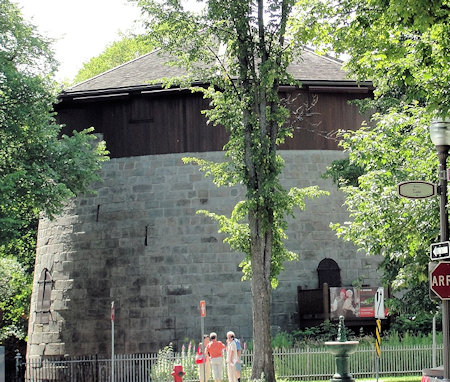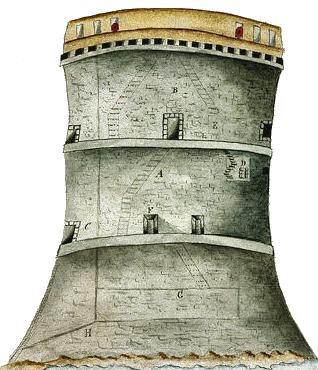Martello Towers in Canada
Fifteen Martello towers were built in Canada between 1796 and 1870. but only eleven still survive. The early towers were built by the British to defend against the French. The later towers were built as a consequence of political tensions between Canada and the United States.
A common characteristic of Canadian Martello towers was removable cone-shaped roofs to protect against snow. Today, many of the restored towers have permanent roof additions – for ease of upkeep, not historical accuracy. 


Quebec No.1 Martello Tower

Quebec No.2 Martello Tower

Construction began in the summer of 1808 on four Martello towers to guard the westward land approaches to Fortress Quebec. The four towers were designed as an interlocking advanced defense system that could be destroyed from the fort if overrun.
The towers were completed by the start of the War of 1812 but they never were attacked. The towers were abandoned for military purposes when British troops departed Canada in 1871 but were used for other purposes after that.
Tower 3 was destroyed in 1904 to make way for the McKenzie Memorial Building of the Jeffery Hale Hospital.
Current Status
Destroyed in 1904. Site is on the north side of Rene-Levesque Blvd between Turnbull St. and Claire-Fontaine St. in Quebec City, Quebec, Canada. Site is overbuilt with the McKenzie Memorial Building. No markers or interpretive signs and no period guns or mounts.

Quebec No.4 Martello Tower c1900
The Duke of Clarence Martello Tower stood on the Dartmouth shore. A British colonial Martello tower established in 1798 by Prince Edward, fourth son of King George III. Designed by Captain James Straton, Commanding Royal Engineers. Officially named Duke of Clarence's Tower on 20 Oct 1798 for the Duke of Clarence by his brother Prince Edward.
The Duke of Clarence Tower was built of sandstone to be 35' high, with a diameter of 50'. The walls were 6' thick to the top. The tower was three stories high and could accommodate 164 troops. A seven-foot wide, 8-foot deep ditch surrounded the base of the tower.
In 1863-69 the third story was removed and the tower became a barracks and magazine. The tower was demolished in 1889.
Duke of Clarence Martello Tower, a British colonial Martello tower established in 1798 by Prince Edward, fourth son of King George III. Designed by Captain James Straton, Commanding Royal Engineers. Officially named Duke of Clarence's Tower on 20 Oct 1798 for the Duke of Clarence by his brother Prince Edward. Demolished in 1889.
One of five Martello Towers built for the defense of Halifax Harbor. The towers were mainly designed to provide land side protection for water facing batteries.
When Great Britain and France again went to war in 1793, Halifax’s role as a fortified stronghold and naval base once more came to the fore. Prince Edward, Duke of Kent, a son of George III and later the father of Queen Victoria, sailed into Halifax in 1794 to become its commandant.
Prince Edward had an immediate impact in Halifax and, among other projects, built a proper fort on Georges Island in 1798. He named the star-shaped fortification Fort Charlotte after his mother, Queen Charlotte. Later, during the war of 1812, a Martello Tower was added to the fortifications on the island. Altogether five such towers were eventually built in Halifax.
Sherbrooke Martello Tower (1814-1866) - A British colonial Martello tower established in 1814 at present day Magruder Beach on McNab Island, Halifax, Halifax County, Nova Scotia, Canada. Designed by Colonel Gustavus Nicolls, Commanding Royal Engineers. Completed in 1828 and placed in use as a lighthouse.

Sherbrooke Martello Tower Site under the Lighthouse
Construction actually started in April 1815. The Sherbrooke Martello Tower was built of granite to be 32' 7" high, with a diameter 50' at the base and 48' 4" at the top. The walls were seven feet thick. The tower was originally designed to be two stories high but a third story was added in 1828 to house a lighthouse. The tower was designed to mount seven 24-pounder cannons, four on the lower level and three on the second floor but it was never armed and not used for military purposes..
The tower was completed 30 Jun 1828 and placed in use primarily as a lighthouse. The structure remained up until after World War II when it was replaced by the present lighthouse.
Destroyed, site built over by the current McNab's Island lighthouse, archeological remains only.
Halifax, Nova Scotia, had five towers, the oldest of which, the Prince of Wales Tower located in Point Pleasant Park, is the oldest Martello-style tower in North America. It was built in 1796 and was used as a redoubt and a powder magazine. Restored, it is now a National Heritage site.
The Duke of York Martello Tower was built in 1798 at York Redoubt. Its lower level still stands, though it has been boarded up for conservation purposes.
Sherbrooke Martello Tower stood opposite York Redoubt on McNabs Island; it was demolished in 1944 and replaced by a concrete lighthouse at Maughers Beach.
Four Martello towers were built at Kingston, Ontario to defend its harbour and naval shipyards in response to the Oregon Crisis. Their builders intended for the towers to serve as redoubts against marine attacks. Murney Tower and the tower at Point Frederick (at the Royal Military College of Canada) are now museums that are open during the summer.
Line of defence: three Martello towers Fort Frederick, Shoal Tower, and Cathcart Tower in Kingston, Ontario
Fort Frederick has the most elaborate defences as it includes earthen ramparts and a limestone curtain wall.
Carleton Martello Tower, overlooking the harbour of Saint John, New Brunswick, is now a museum and a National Historic Site.

Cathcart Martello Tower August 2020 (Ack.5)

Murney Martello Tower August 2020 (Ack.5)
Please visit www.kingstonhistoricalsociety.ca/the-murney-tower/ for more information
Shoal Tower, originally known as Victoria Tower, is a Martello tower located in the harbour (Confederation Basin) of Kingston, Ontario, Canada, directly opposite Kingston City Hall.
It is one of four such towers built in the 1840s to protect Kingston's harbour and the entrance to the Rideau Canal.
Cathcart Tower on Cedar Island, Shoal Tower in the Confederation Basin, Fort Frederick on the grounds of the Royal Military College of Canada, and Murney Tower were part of the same strategic improvements.

Shoal Martello Tower August 2020 (Ack.5)
Built in 1847, this limestone tower is 11 m high and 16.5 m in diameter. The guns of Shoal Tower defended the approaches of Kingston Harbour.
A dispute between Great Britain and the United States over the boundary between British Columbia and Oregon that threatened to lead to war and to the invasion of Canada (see Oregon crisis) prompted their construction.
Eventually, Shoal Tower was abandoned. It was designated a National Historic Site of Canada in 1930 and is part of the Kingston Fortifications National Historic Site.
Since 2005, it is open to the public as part of Doors Open Ontario for one day only in June each year.







 Red Dragon I.T. Ltd.
Red Dragon I.T. Ltd.